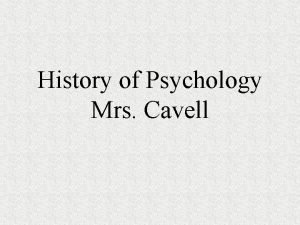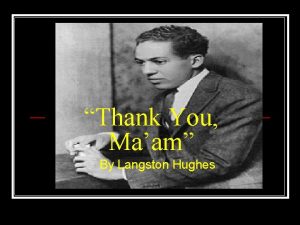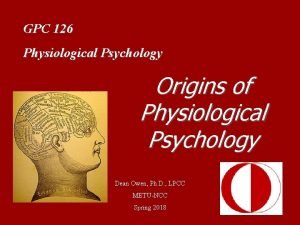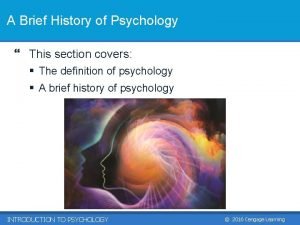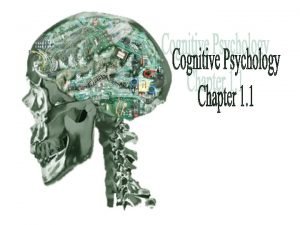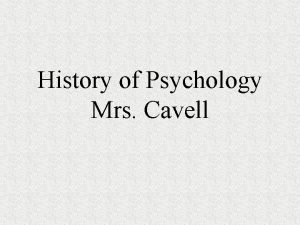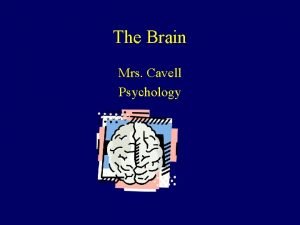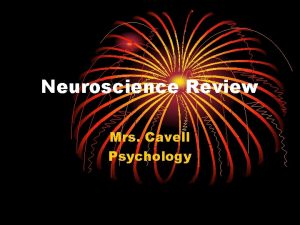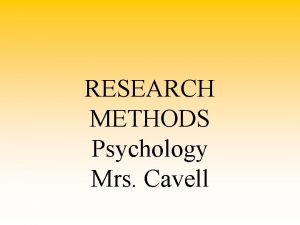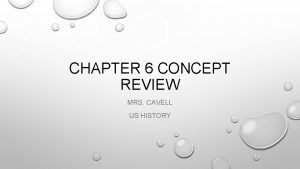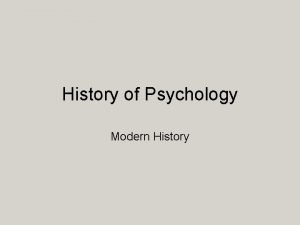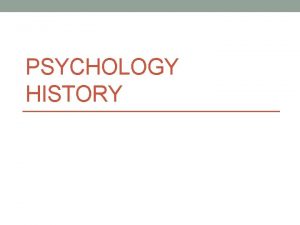History of Psychology Mrs Cavell How do you


















- Slides: 18

History of Psychology Mrs. Cavell

How do you feel today? A. Happy…I love school!! B. Ehh…no opinion! C. Sad I am sleepy!

Which of the following shows do you watch or find interesting? A. Hoarders B. My Strange Addiction C. Intervention D. Never watch these types of shows

What is Psychology? The science of behavior and mental processes Behavior—observable actions of a person or animal Mind—thoughts, feelings, sensations, perceptions, memories, dreams, motives and other subjective experiences Science--an objective way to answer questions based on observable facts/data and well-described methods • Four Goals of Psychology: Ø Describe: What is the person doing? Ø Explain the cause(s) of the behavior. (Genetic, Biological, Environmental) Ø Predict: When/How will a person behave in certain situations? Ø Control: Can a psychologist help control undesirable behaviors.

Turn, Talk and WRITE! • Turning to a close neighbor, flip over this outline and think about a person you know that has a “abnormal” behavior in your opinion and fill in the goals of Psychology using this behavior. • FOR EXAMPLE…

Mrs. Cavell’s Example • Describe: Student A repeatedly enters class and licks his desk. • Explain: Student A may have OCD and feels compelled to lick his desk or perhaps it is the constant harassment from Student B also in my class • Predict: It happens everyday during Channel One • Control: When Student A feels overwhelmed by licking his desk, he will use a substitute (lick a sucker) or he will repeat a calming phrase until the thoughts go away.

What are the criteria for determining abnormality? • 1. Atypical: Different from the perceived norm • 2. Disturbing: Behavior would be unacceptable to most of the culture • 3. Maladaptive: Behaviors that increase the risk of injury to the person • 4. Unjustifiable: No logical explanation for the behavior

Let’s Practice! • We know the goals of Psychology and the criteria for determining abnormality…so let’s put our knowledge to work. • OCD: Obsessive-Compulsive Disorder: Persistent irrational thoughts or impulses that causes the person to engage in senseless rituals or behaviors • We are going to watch a portion of the show HOARDERS. Fill out the form provided to practice being a psychologist!

Historical Foundations

Wilhelm Wundt –The “Father of Psychology” –Founder of modern psychology –Opened the first psychology lab in 1879 –applied laboratory techniques to study of the mind Wilhelm Wundt (1832– 1920)

Structuralism • Structuralism: Studied the basic elements (structure) of thoughts and sensations. • focused on how our 5 senses allowed humans to navigate their environment • measured reaction times • INTROSPECTION: Presenting a stimulus to a particular sense and having subjects report their conscious mental experiences.

William James • First American psychologist • Influenced by Charles Darwin • Author of the first psychology textbook (Principle’s of Psychology) • Founder of Functionalism – focused on how behaviors help us adapt to the environment/how our brain adapts to new situations William James (1842– 1910)

DAILY DOUBLE

Explain the difference between Structuralism & Functionalism. Structuralism – basic parts of a person’s thoughts and feelings. Focus on basic senses & perception. Functionalism – how our consciousness helps us to function or adapt to our environment.

John B. Watson • Founder of Behaviorism • Behaviorism: Studying only observable and objectively described acts (Little Albert) • Emphasized objective and scientific methodology • The goal of his research was to make psychology a scientific pursuit and conduct experiments that could be REPLICATED John B. Watson (1878– 1958)

Little Albert Experiment • In 1920, Professor John Watson decided he would attempt an experiment that would condition a 1 year old baby to fear something that previously evoked no fear response. • “Albert” was an orphan and Watson received permission to take from the orphanage and use him in his experiment. • Let’s see what happens!

Sigmund Freud (1856 -1939) • Austrian physician that focused on mental illness • Theorized that the first 5 years of life were critical to personality development. • Psychoanalysis: Belief that abnormal behavior originated from unconscious (unaware) drives and conflicts

Freud’s Influence – Freudian slips (Nothing is an accident) When you say something that you didn’t mean to say – Example: “The Mole” from Austin Powers – Let’s Watch!!
 Difference between functionalism and structuralism
Difference between functionalism and structuralism They are mrs garcia and mrs castro
They are mrs garcia and mrs castro They are mrs garcia and mrs castro
They are mrs garcia and mrs castro Mrs. darling was ___________ of mrs. s.
Mrs. darling was ___________ of mrs. s. Ms turnbull world history
Ms turnbull world history Thank you ma'am langston hughes setting
Thank you ma'am langston hughes setting Positive psychology ap psychology definition
Positive psychology ap psychology definition Aggressive role
Aggressive role Social psychology ap psychology
Social psychology ap psychology History and origin of science of psychology slideshare
History and origin of science of psychology slideshare Social psychology is the scientific study of:
Social psychology is the scientific study of: Health psychology definition ap psychology
Health psychology definition ap psychology Wilhelm wundt structuralism
Wilhelm wundt structuralism Definition of physiology
Definition of physiology Emphasis
Emphasis History of criminal psychology
History of criminal psychology History of cognitive psychology
History of cognitive psychology Brief history of psychology
Brief history of psychology History of cognitive psychology
History of cognitive psychology
